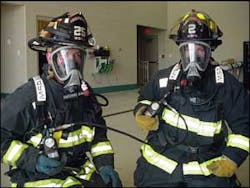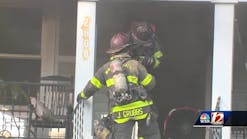Sharing air between firefighters is not a recommended or approved procedure as far as NFPA, NIOSH, OSHA or any manufacturer are concerned.
This is the fifth and final part in a series of articles focused on considerations for proper and safe S.C.B.A. use. It is important to stress that the procedures introduced are to be utilized only under extreme circumstances. The procedures are meant to be utilized as last resorts in saving your own life or that of another firefighter.
According to the 2002 edition of NFPA 1981 (Standard on Open Circuit Self Contained Breathing Apparatus for Fire and Emergency Services), manufacturers must produce S.C.B.A. units that contain a Rapid Intervention Crew Universal Air Coupling (RIC UAC) to be in compliance for firefighting. This connection will allow a cylinder that is low on air to be transfilled from another cylinder regardless of manufacturer. Each cylinder will then have equal amounts of air in them after the fill. This universal connection must be permanently fixed to the unit within four inches of the threads of the S.C.B.A. cylinder valve. These requirements only apply to newly manufactured S.C.B.A. Existing S.C.B.A. are able to be retrofitted with this feature but are not required.
Sharing air between firefighters is not a recommended or approved procedure as far as NFPA, NIOSH, OSHA or any manufacturer are concerned. Even with factory installed Emergency Breathing Support Systems (EBSS), these agencies do not have any guidelines or certification procedures for S.C.B.A. when they are used to support two users.
However, using the EBSS is a very important skill that all firefighters should become familiar with if their S.C.B.A. has the capability because it may be the only option that they have when they are faced with a life or death situation. Buddy breathing skills are very difficult to train on and proficiency in the basic fundamentals of S.C.B.A. use should be stressed prior to introducing a firefighter to them. Most problems with any form of buddy breathing take place while firefighters are attempting to move towards safety and for this reason the skills should be practiced while moving. Buddy breathing skills should only be practiced in a non-toxic environment. As firefighters become more skilled in the procedures, the difficulty level can be increased by obscuring their vision through the S.C.B.A. facepiece while practicing.
Most S.C.B.A. units on the market offer some form of an emergency breathing support system (EBSS) as an option. The advantage to a system such as this is that a firefighter never has to remove their facepiece. Each particular manufacturer will have specific instructions for using the system that is equipped on their unit. In general terms for all units, the following points need to be recognized by firefighters.
- Become thoroughly familiar with the system and how it works. This includes all couplings that may need to be connected or disconnected. It is under adverse conditions that the system will need to be utilized. Firefighters should be able to operate the system while wearing gloves and with obscured vision.
- The rescuer must take charge and be in control. This is imperative because the rescuer is not the one in trouble and therefore will be calmer and focused in handling the situation.
- Before hooking into a support system, the rescuer should make certain that there is a sufficient air supply to do so. If not, another means of escape must be considered. Does the system equalize the air cylinders of both firefighters or are both firefighters now breathing off one tank of air? Most manufacturers will not advise utilizing a system unless the rescuer has at least one half the rated capacity of air in their S.C.B.A. cylinder. Whatever the case, both firefighters must realize that they will have to be calm and in control of their breathing while operating on a very limited air supply.
- Once connected, the movement of the two firefighters must be coordinated. The firefighter being rescued should follow the lead of the firefighter supplying air. Are the firefighters required to be connected or can the hose between them be disconnected once the transfill takes place? If connected by facepiece mounted regulators, the firefighters must be careful not to dislodge one another's mask while moving. Firefighters must also make certain that they do not get their connection hoses entangled in objects and must move in a coordinated fashion so that they do not cause each other to be off balance. As mentioned prior, moving while buddy breathing is a very difficult task and must be practiced on a continual basis.
The fireground is a very dynamic and dangerous environment. Every firefighter from the most seasoned veteran to the greenest rookie can experience a problem with their S.C.B.A. Emergency procedures involving S.C.B.A. should be second nature to all firefighters. As with all aspects of firefighting, practice and training prior to an emergency will only increase a firefighter's chance for survival.More information on Emergency S.C.B.A. Techniques can be obtained from the text R.I.C.O., Rapid Intervention Company Operations.
See Battalion Chief Jeffrey Pindelski Live! Battalion Chief Pindelski and other top RIC instructors will be hosting the R.I.C.O Seminar, Sept. 18-22 in the Chicago Metro area.
Related:
- S.C.B.A. Considerations: Air Management Is Critical on Fireground
- Air Consumption for Fire Ground Survival
- S.C.B.A. Restrictive Area Techniques
- S.C.B.A. Entanglement Hazards
Jeffrey Pindelski is a 16 year plus student of the fire service and currently a Battalion Chief with the Downers Grove Fire Department in Illinois. He previously served for 12 years as a Firefighter and Lieutenant on the Truck and Heavy Rescue Company. Jeff is a staff instructor at the College of Du Page and also instructs courses at the Downers Grove Fire Academy. He has been involved with the design of several training programs dedicated to firefighter safety and survival and is the coauthor of the text R.I.C.O., Rapid Intervention Company Operations.






